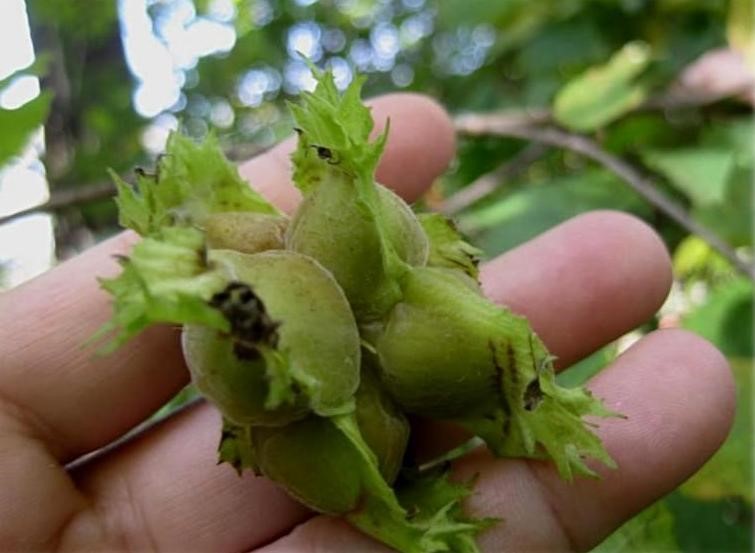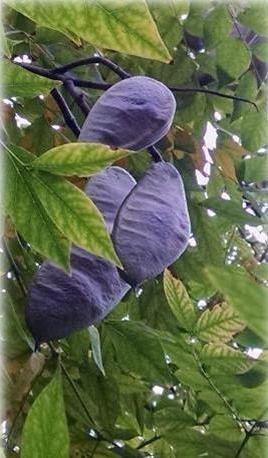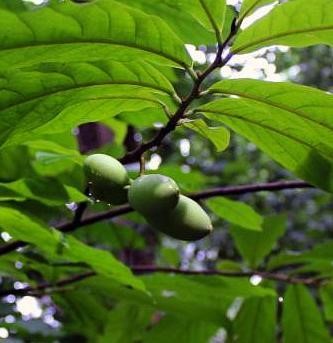As we head into autumn we see many of the tree fruits and nuts ripening in the forests and meadows around us. It is the time of year that small animals and some large ones will be searching for delectable, high calorie foods. Here are some of the fruits and nuts that you can find while strolling at Tyler. Remember, please look but do not collect or ingest. We have many visitors who would also like to discover our plants, and our wildlife relies on this food to see them through the long, cold winter.

American filbert (Corylus americana) can be found just a few steps from our spring house located in the valley below Lachford, in the area we call the Old Arb. An old grove, this large arching shrub produces nuts in late summer. The nuts are encased in a green papery wrapping called involucre, which tends to hide the nuts from foragers. When the nuts are ripe, the involucre will be brown in color and should be harvested immediately. The nuts are eaten by squirrels, foxes, deer, northern bobwhite, ruffed grouse, turkey, woodpeckers, pheasants and deer.
Two trees that produce interesting fruits are the ginkgo (Ginkgo biloba) and the Kentucky coffee tree (Gymnocladus dioicus), if they are female trees and are pollinated. The ginkgos around Tyler are male. Our former state champion Ginkgo grows by Lachford patio and is one of our Painter Era trees. Ginkgo nuts are harvested and the foul smelling pulp is removed. Be careful as the pulp contains urushiol, which is also found in poison ivy. Larger than pistachios but with thinner shells, the nuts are high in niacin, starch and protein. However, they also contain toxins and therefore should not be eaten in great quantities. Growing up in a Chinese household, mom used to make ginkgo nut soup for us.

Acting as a sentinel, our majestic Kentucky coffee tree (Gymnocladus dioicus) grows by the path to the Butterfly House. This sizable adult male tree has a distinctive coarse branching habit as well as scaly bark. One of the last trees to leaf out and the earliest to drop its leaves, the Kentucky coffee tree is referred to as the “scary Halloween tree” by Tyler’s Docents. Large seed pods are produced in late October and persist throughout the winter. When open, the seeds are covered by a highly poisonous, gelatinous substance. Native Americans and early American settlers, especially those in the Kentucky territory, roasted and ground the seeds to brew a coffee-like beverage (albeit with no caffeine), hence the common name. Seeds contain saponin and are also very toxic prior to roasting. Scientists have not identified any modern day animal that would ingest the fruits. It’s probable that giant sloths, mastodons, mammoths and other large mammals – megafauna that lived on this continent for millions of years and became extinct only 10,000 to 20,000 years ago – were this tree’s seed dispersers.
Located by the Edible Garden picnic area, you will find two large native black walnuts (Juglans nigra). Most people who have this tree in their yards either love or hate it. For those who can crack these nuts, the nut meal is fantastic in pies and cakes. Animals that love walnuts include squirrels, turkeys, raccoons and bears. Walnut trees will produce a toxic substance called juglone that prevents many plants from growing under or near them, effectively decreasing competition. For the gardener, this is a real challenge.
If you are lucky, you may be able to spot some pawpaw (Asimina triloba) fruits still on the trees when you stroll through the Native Woodland Walk. The fleshy fruits are greenish to yellow and have the taste and consistency of bananas. Fruits are frequently eaten raw or used in ice creams, cakes or pies, although they can cause nausea in s ome people. Raccoons, squirrels and opossums are on the hunt for these fruits and often beat humans to the harvest. The zebra swallowtail butterfly and the pawpaw tree have co-evolved. The sole source of food for the zebra swallowtail caterpillars is the foliage, particularly the young leaves, of pawpaws. If you see one of these distinctive, long-tailed butterflies glide past, it’s likely there’s a pawpaw patch nearby.
ome people. Raccoons, squirrels and opossums are on the hunt for these fruits and often beat humans to the harvest. The zebra swallowtail butterfly and the pawpaw tree have co-evolved. The sole source of food for the zebra swallowtail caterpillars is the foliage, particularly the young leaves, of pawpaws. If you see one of these distinctive, long-tailed butterflies glide past, it’s likely there’s a pawpaw patch nearby.
This is just a small sampling of trees that produce interesting fruits and nuts. Some require expert handling and processing to consume, whereas with others you just need to get there in time! All of these wild fruits and nuts have a place in our history and it’s nice to remember as we walk through the arboretum, that we are surrounded by foods that people have relied on for thousands of years.






